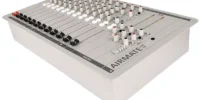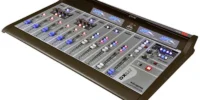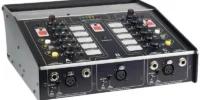The
Sonifex S2 Radio Broadcast Mixer is a modular broadcast mixer which offers digital audio quality with analogue reliability in a modular format. The
Sonifex S2 has both digital and analogue input channels, together with simultaneous analogue and digital outputs. S2 combines all the features needed of a radio broadcast mixer in a stylish, flush-mounting chassis : a wide range of input and output channels, PFL/cue, fader-start operation of equipment, automatic monitor muting on mic-live, light controlling remote outputs, optional EQ on input modules, gram amp input options and 2 main audio buses, allowing you to broadcast on the PRG bus while recording on the AUD bus, with bus output selection on each module.
Sonifex S2 Input Channels – Intro
There is a wide choice of input channels for the S2 mixer. Each channel has a number of common features :
Assigning an Input Channel to an Output Bus – Switches at the top of the channel are used to select the output group routing, to either Program, Audition, or both output buses. Selecting the PGM and/or AUD buttons routes the channel audio to the PGM and/or AUD mix buses. The buttons illuminate green to indicate the routing status.
Changing the Input Level – Coarse gain is set using pre-set potentiometers on the channel circuit board which allow unbalanced inputs to be used on mono and stereo line inputs. The front panel TRIM control allows fine gain of ±12dB.
Changing the Signal Pan, or Balance – The BAL/PAN control is used on mono channels to pan the mono input signal in the stereo image and on stereo channels to balance the stereo image.
CUE/PFL (Pre Fade Listen) – Selecting the CUE/PFL button routes the pre-fader input signal to the monitoring system where the signal can be heard via headphones and/or loudspeakers. The button lights green when CUE/PFL is active and a jumper option is available to cancel the CUE/PFL selection when the fader is raised. This button works with both a momentary and latched operation – if held down, the selection is cancelled on release, otherwise the button is alternate action.
Fader Start & ON Button Control – The ON button works in conjunction with the 100mm long-throw carbon fader and is used to control channel remotes (e.g. starting a CD player), routing and timers, etc. When unlit, the channel is off. Flashing red indicates that the channel has been selected to ON but not routed to either PGM or AUD. Steady red indicates that the channel is ON and “armed”, ready for the fader to be raised. Raising the fader changes the illumination to green indicating that the channel is live. Alternatively, with the button unlit the fader may be raised and the channel can be operated simply by selecting ON. The illumination in this case toggles between unlit (channel OFF) and green (channel ON).
Programmable Button Settings
To make the S2 modules as flexible as possible, every button on each channel can be set to a number of different modes to aid the use of the mixer and allow for extra functionality. Each button can be set to either operate manually, be permanently on, or permanently disabled. Also, the ON button can be configured to operate in a number of modes, altering remote start functions, and the channel ON function can be controlled remotely by automation playout systems, such as RCS® or VCS.
Scribble Pad – A scribble pad is provided at the bottom of the channel for user labelling of the channel function.
Sonifex S2 Output Channels – Intro
There are six different output channels available, for controlling monitoring in both a Control Room and separate Studio, with the two main output channels also having a master fader option.
The master output channels provide balanced analogue audio outputs as well as simultaneous AES/EBU or S/PDIF digital audio outputs for both PRG and AUD buses. The analogue mono output can be selected from PRG or AUD and meter selection is available to show either the PRG bus, AUD bus, or to follow the Control Room Monitor selection.
Both Control Room and Studio Monitor channels are available for controlling what’s routed to the presenter’s and guest’s headphones and monitor speakers. 2 external inputs can also be monitored.
A minimum of 3 channels need to be fitted into a mixer: channels S2-OMC, S2-ODP (or S2-ODPF) and S2-ODA (or S2-ODAF) must be fitted and S2-OMS is optional.
Sonifex S2 Meterbridge Modules – Intro
In the meterbridge area you can choose from four styles of metering, a phase meter, a dual timer, a PFL/Talkback loudspeaker, 2 talkback modules, a 6 input source selector and a range of blanking plates. S2’s meterbridge modules are freely assignable so that you can position them exactly where you want them.
S2’s meterbridge modules are freely assignable so that you can position them exactly where you want them.
The dual meter panels are used for monitoring console signal levels. Up to three different meter panels can be housed in the meterbridge. The meters can be configured internally to be fed from one of three signal sources, the selected source indicated by a LED:
- Select – The output of the meter switch on the AUD output module which can show PGM, AUD, or CR MON, which is the selected monitor source on the control room monitor module, (EXT 1, EXT 2, PGM, or AUD)interrupted by PFL.
- Program – PGM output which can optionally be interrupted by PFL.
- PFL – The output of the PFL bus.
Sonifex S2 Chassis Design
The Sonifex S2 chassis is available in 5 channel width sections, allowing 5, 10, 15, 20, 25 and 30 channel width mixers. This means S2 can be used for small newsrooms or large on-air situations.
This mixer can be ordered in various configurations several of which are priced above, please contact us for your custom design.




